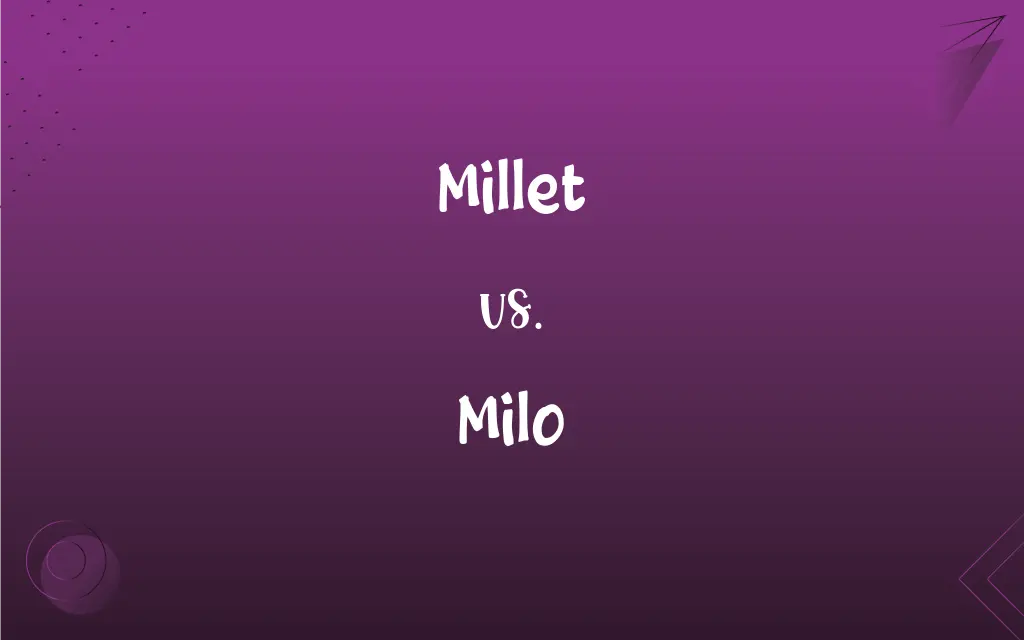Millet vs. Milo: What's the Difference?
Copy edited by Janet White || By Aimie Carlson || Published on November 27, 2023
Millet refers to various small-seeded grasses used as cereal crops, while milo, also known as sorghum, is a specific grain crop often used for fodder and syrup.

Key Differences
Millet encompasses a group of small-seeded grasses cultivated as cereal crops, known for their ability to grow in harsh environments. On the other hand, milo, a term often used interchangeably with sorghum, is a specific type of grain, primarily used for animal feed, grain production, and making sorghum syrup.
Millet varieties are diverse, including pearl millet, finger millet, and foxtail millet, each with unique characteristics and uses in different cuisines. However, milo, or grain sorghum, is characterized by its large, plump grains, and is predominantly cultivated in arid regions for its drought-resistant properties.
Millet grains are often used in traditional dishes across Africa and Asia, and are valued for their gluten-free property. Milo, while also used in some human diets, is more commonly utilized as livestock feed in many parts of the world, particularly in the United States.
Millet is known for its rapid growth and short growing season, making it a reliable crop in semi-arid regions. In contrast, milo, though also drought-resistant, typically has a longer growing season and is used in crop rotation practices for soil health.
Nutritionally, millets are a good source of fiber, vitamins, and minerals, and are used in porridges, breads, and beverages. Milo grains are rich in nutrients as well, but their primary use in animal feed and syrup production differentiates them from millets.
ADVERTISEMENT
Comparison Chart
Definition
Small-seeded grasses, various types
A specific type of grain crop
Primary Use
Cereal crop for human consumption
Fodder for animals, grain, and syrup
Varieties
Includes pearl, finger, and foxtail millet
Primarily one type, grain sorghum
Growing Conditions
Grows in harsh, semi-arid environments
Drought-resistant, needs longer season
Nutritional Value
High in fiber, vitamins, and minerals
Used more for animal feed
ADVERTISEMENT
Millet and Milo Definitions
Millet
A cereal grain used in various global cuisines.
She made a delicious porridge using millet.
Milo
A type of grain sorghum.
Milo is a key ingredient in livestock feed.
Millet
A gluten-free grain alternative.
Millet flour is great for gluten-free baking.
Milo
Used primarily for animal fodder and syrup.
The farmer harvested milo for his cattle.
Millet
Used in traditional dishes like porridge and bread.
For breakfast, they often eat millet bread.
Milo
Characterized by large, plump grains.
Milo grains are larger than those of other sorghums.
Millet
A drought-resistant crop grown in semi-arid regions.
Millet thrives in their dry farmland.
Milo
Sometimes used in human diets but mainly for livestock.
Besides feeding livestock, some cultures cook with milo.
Millet
French painter of rural scenes (1814-1875)
Milo
Grown in arid regions for drought resistance.
They cultivate milo in dry areas for its hardiness.
Millet
A group of small-seeded grass crops.
Millet is a staple food in many parts of Africa.
Milo
Any of various sorghums that are cultivated for their grain, which resembles millet. Also called grain sorghum.
Millet
Any of various annual grasses with small grains that are harvested for food, livestock feed, and birdseed, especially proso millet.
Milo
(US) sorghum
Millet
The grains of any of these plants.
Milo
Small drought-resistant sorghums having large yellow or whitish grains
Millet
A demographic group in the Ottoman Empire, defined in terms of religious affiliation and enjoying a degree of legal autonomy.
Millet
Any of a group of various types of grass or its grains used as food, widely cultivated in the developing world.
Millet
(specifically) common millet, in particular Panicum miliaceum.
Millet
(historical) A semi-autonomous confessional community under the Ottoman Empire, especially a non-Muslim one.
Millet
The name of several cereal and forage grasses which bear an abundance of small roundish grains. The common millets of Germany and Southern Europe are Panicum miliaceum, and Setaria Italica.
Millet
Any of various small-grained annual cereal and forage grasses of the genera Panicum, Echinochloa, Setaria, Sorghum, and Eleusine
Millet
Small seed of any of various annual cereal grasses especially Setaria italica
FAQs
Are all millets the same?
No, there are different varieties like pearl, finger, and foxtail millet.
What is millet?
Millet refers to various small-seeded grasses used as cereal crops.
Is milo the same as sorghum?
Yes, milo is another term for grain sorghum.
Is milo used in human food?
While it can be, milo is primarily used for animal feed and making sorghum syrup.
Can humans eat millet?
Yes, millet is commonly consumed by humans, especially in gluten-free diets.
What is milo?
Milo, also known as sorghum, is a grain crop used for animal feed and syrup.
Does millet require a lot of water?
No, millet is drought-resistant and grows well in dry conditions.
Where is millet grown?
Millet is widely grown in Africa, Asia, and semi-arid regions.
Is millet gluten-free?
Yes, millet is a popular gluten-free grain alternative.
What differentiates milo from other grains?
Milo is notable for its large grains and use in animal feed and syrup production.
Is milo good for soil health?
Yes, it's often used in crop rotation to maintain soil health.
Is millet used in animal feed?
While possible, it's more commonly used for human consumption.
Where is milo grown?
Milo is mostly grown in arid regions, like parts of the United States.
What are the nutritional benefits of millet?
Millet is rich in fiber, vitamins, and minerals.
What is the growing season for milo?
Milo typically has a longer growing season compared to millet.
What are common uses of milo?
Common uses include livestock feed and sorghum syrup production.
Can milo be used for syrup?
Yes, milo is often used to make sorghum syrup.
How is millet harvested?
Millet is harvested when the grains are dry and the plant has turned brown.
Is milo drought-resistant?
Yes, milo is known for its drought-resistant properties.
What dishes can be made from millet?
Millet can be used in porridges, breads, and various traditional dishes.
About Author
Written by
Aimie CarlsonAimie Carlson, holding a master's degree in English literature, is a fervent English language enthusiast. She lends her writing talents to Difference Wiki, a prominent website that specializes in comparisons, offering readers insightful analyses that both captivate and inform.
Copy edited by
Janet WhiteJanet White has been an esteemed writer and blogger for Difference Wiki. Holding a Master's degree in Science and Medical Journalism from the prestigious Boston University, she has consistently demonstrated her expertise and passion for her field. When she's not immersed in her work, Janet relishes her time exercising, delving into a good book, and cherishing moments with friends and family.






































































